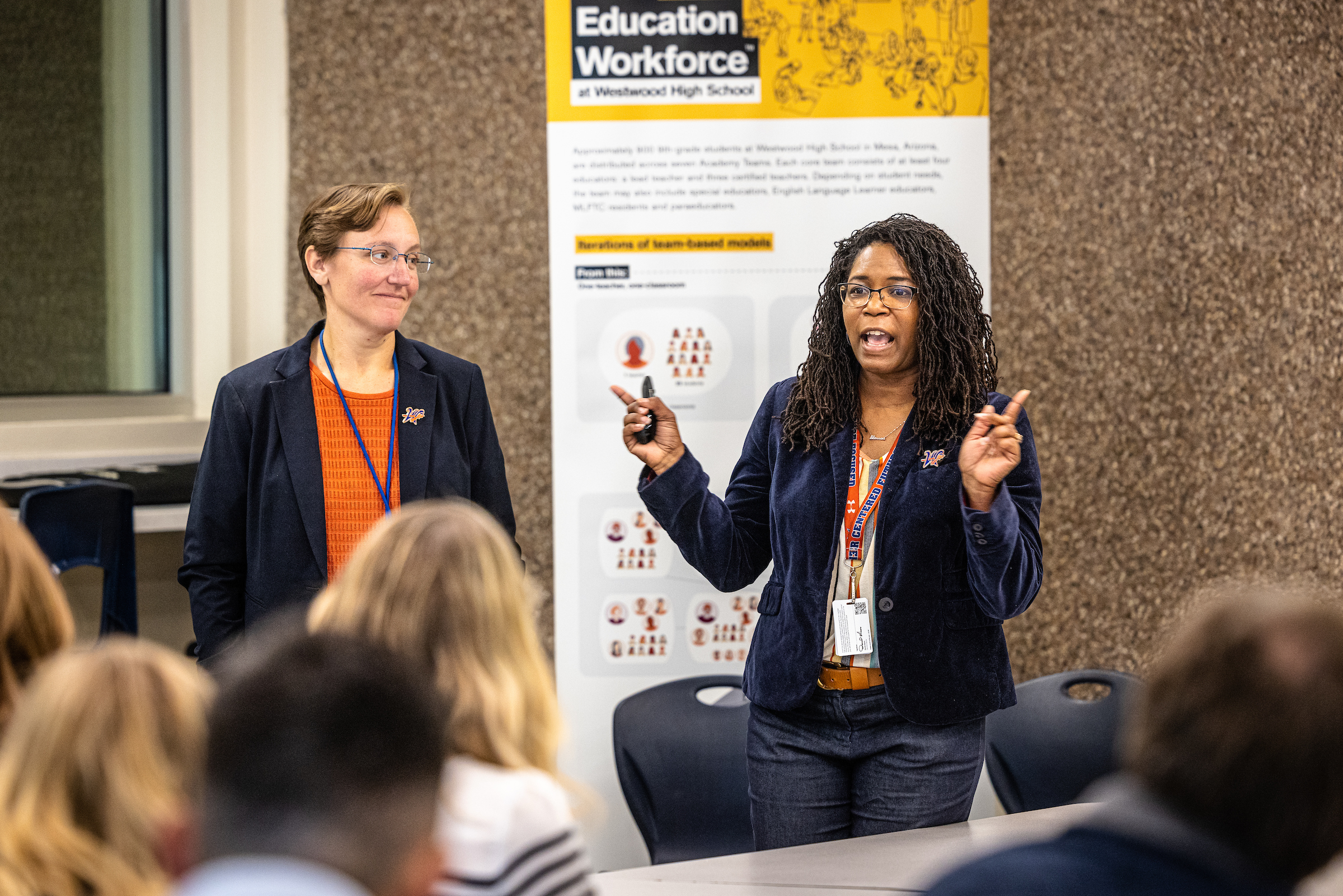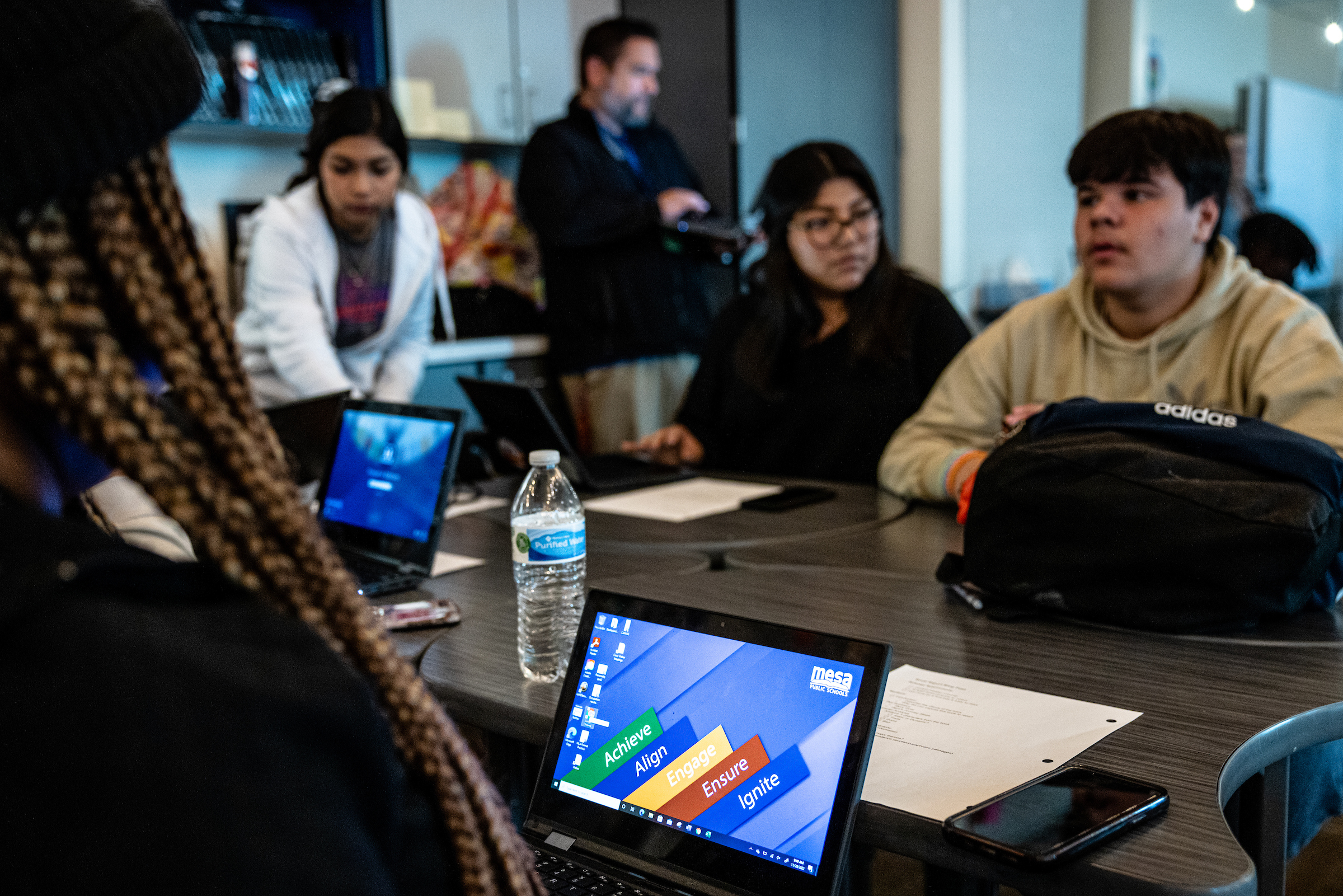Editor’s note: This story is featured in the 2022 year in review.
Kirtland Kack stands at the front of the room, microphone in hand.
The Mesa Westwood High School ninth grade world history teacher is asking his class to be quiet and pay attention.
It’s not an easy task, given there are 135 kids in the room.
But he has help.
A science teacher sees that six kids at one table have strategically placed a backpack on the table in order to prop up — and hide — a cellphone showing a World Cup soccer game. He tells them to put the phone away.
Math and English teachers — stationed at opposite sides of the room — ask for quiet and get it.
“Do I have everyone’s attention?” Kack asks.
He does.
At the back of the room, watching, is Thad Gates, Title IX coordinator at Florence Unified School District. Gates, along with educators from Fountain Hills, Arizona, Washington D.C., Kansas City and even as far as South Africa, are observing the team-teaching model employed by Westwood for its 900 freshmen students to see if it will be a good fit for their school systems.
“I can see why this would be good for teachers,” Gates says. “The burnout, the feeling of being alone in a class, isn’t there. We’re intrigued by it, and we’ll probably have some deeper conversations after our visits to see if we can start the planning for our district.”
Westwood is one of 50 schools across 10 school systems that have put into practice the team-teaching approach, which was born out of conversations school officials had five years ago with leaders from Arizona State University’s Mary Lou Fulton Teachers College.
Dean Carole Basile and a team of faculty and staff at the Teachers College developed the design principles of the approach, which acknowledges — and addresses — realities in the teaching profession.
A 2019 study by the Johns Hopkins Institute for Education Policy revealed that 13.8% of high school teachers are either leaving their school or leaving teaching altogether. While enrollment in ASU’s teacher-preparation programs has increased since 2016, the national trend is one of decreasing enrollment. According to a Learning Policy Institute Report, teacher education enrollment has dropped 35% in recent years. Additionally in Arizona, 35,000 people who are certified to teach have opted not to do so.
“We have manufactured a system that creates crisis on a daily basis,” said Brent Maddin, executive director of the Next Education Workforce initiative at the Teachers College, which works with schools to redesign staffing and instruction. “Preparing a teacher is really hard work. And if they’re peeling out of the profession after a year or two, this is bad for kids, this is bad for educators, this is bad for our democracy. What we’re doing is totally a retention play.”
Brent Maddin joins around 35 other tour administrators and educators in listening to Mesa's Westwood High School assistant principals and student ambassadors during a Nov. 29 presentation of the team-teaching model the school has implemented. Photo by Charlie Leight/ASU News
How does the team-teaching model work?
Teachers are no longer on an island, in a single classroom, solely responsible for preparing curriculum, teaching, grading, discipline, planning, etc.
At Westwood, for example, a team teaching more than 130 ninth graders includes an English teacher, agriculture teacher, career exploration teacher, instructional specialist and math teacher. The school, part of Mesa Public Schools, also employs student teachers from the Teachers College.
Kyrene de las Manitas Elementary School in Tempe employs four “learning studios” for students from kindergarten through sixth grade. Each studio includes a lead teacher known as the Teacher Executive Designer, two team teachers and two to three paid student teachers.
“The more eyes we have on these kiddos, the more successful they’re going to be,” said Vatricia Harris, assistant principal at Westwood.
Early data bears that assumption out.
Westwood Assistant Principal Katie Gardner said that prior to the COVID-19 pandemic, 70% of freshmen were earning the credits needed to stay on course for graduation. In fall 2021, the first semester Westwood used the team-teaching model, 84% were on course. In addition, 93% of the freshmen passed Algebra 1.
Sarah Collins, principal at Kyrene de las Manitas, said that in a survey taken last year, 91% of students felt they had someone they could go to with a problem, 96% of staff expressed satisfaction with their jobs and 90% of families were happy with the school’s teaching approach.
“We know the success of these scores has a lot to do with our model,” Collins said.
Assistant principals Katie Gardener (left) and Vatricia Harris speak to a tour group of 35 educators and administrators at Westwood High School in Mesa on Nov. 29. Photo by Charlie Leight/ASU News
Earlier this year, the Institute for Education Policy surveyed more than 3,000 teachers in Mesa Public Schools, which is the Next Education Workforce initiative’s largest district partner. Seventy-five percent of the teachers in the team-teaching model said they were somewhat or extremely satisfied with their teaching job, compared to 66% of traditional classroom teachers in the district.
But numbers don’t tell the true story of, as Maddin put it, the “retention play.”
Voices do.
Team teachers at Westwood and Kyrene de las Manitas said one of the main benefits of the model is its collaborative nature. At Westwood, for example, the teaching teams meet for two hours each morning to discuss the day’s assignments and create a personalized program for every student.
“We just have more of an opportunity to discuss what students need and then provide that to them,” said Westwood ninth grade teacher Adam Tellez-Difusco.
Just as important is the give-and-take between teachers. They can exchange ideas about how to present the day’s material and, when needed, suggest a different approach when a teacher is struggling to implement a concept or is having trouble connecting with an individual student.
Those discussions are supposed to exist in the traditional model, Maddin said, but teachers rarely have time to engage their peers because they’re too busy taking care of everything they need to do for their own class.
“It can be very challenging when you’re struggling with a student and you’re not sure if you’re doing something wrong,” Tellez-Difusco said. “You can send an email to another teacher, but you’re so disconnected there’s no opportunity to dig in.
“But with the four of us sharing a class, one of us can say, ‘I’ve been doing this with this student, and it’s been working pretty well. Maybe you can implement that.’ Working together makes it way easier to give students what they need.”
Added Kack: “There’s still going to be stress in the job, for sure, but there’s less stress because I have someone to bounce ideas off of, to ask, ‘Is this really the right direction? Do you think maybe I’m wasting the kids’ time with this?’ It’s not all on me.”
Kack said the team-teaching model also benefits students when it comes to teacher-student interactions.
“We have 130 students right now and I’d say there’s probably about 30 I have difficulty connecting with,” he said. “That’s going to be expected. But those 30 have other team members they can connect with, and that allows me to communicate through them instead of always running into that brick wall with a student. I can go through the other teachers and figure out what they need. That’s been amazing.”
During class time, the teachers rotate between one-on-one interactions, group instruction and whatever was discussed in the planning meeting in the morning.
Westwood High School students work on their website projects on Nov. 29 in Mesa, Arizona. Photo by Charlie Leight/ASU News
The varied expertise of the teachers allows for cross-curriculum training, which aids students as they progress through their academic career because it parallels the interdisciplinary nature of a college education.
“It’s de-siloed that it’s not just biology content, but it’s biology, math and English language arts applied in the context of an authentic problem that the kids find interesting,” Maddin said. “They can use all three subjects to solve a problem.”
Said Harris: “There’s more research and diving in instead of kids just Googling an answer.”
Kyrene de las Manitas fifth grade teacher Kevin Anway taught by himself for more than 20 years and was skeptical when the school asked him to lead one of its learning studios. But he’s bought into the concept.
“I loved having my own classroom and felt really in control. This is out of my comfort zone,” Anway said. “But having six people in a learning studio, saying, ‘We need to change it up,’ or ‘We should be doing this,’ is the coolest part for me as an educator. We get a revamp of what’s working or what’s not working. That’s something I never had before in 29 years.”
One offshoot of the program is that it reduces the need for substitute teachers. Porter said a teacher in Kyrene’s fifth and sixth grade studio recently missed two weeks with ankle surgery but the school didn’t need to hire a substitute because the other teachers in her grouping took care of the class.
“Children aren’t coming into a class with a person who doesn’t know them or doesn’t know where they are in a lesson,” Porter said. “We didn’t skip a beat with our instruction. It’s really worked out.”
Think of team teaching, Maddin said, as having dual benefits: What helps teachers become better at their jobs in turn helps kids.
“A lot of educational reform often focuses on one or maybe the other, but rarely does it actually attend to both simultaneously,” he said. “I think that’s one of the reasons for its success.”
Top photo: World history teacher Kirtland Kack checks his computer after giving instructions to around 135 ninth graders at Westwood High School in Mesa, Arizona, on Tuesday, Nov. 29. Westwood is taking part in the Next Education Workforce program, which allows teams of teachers to collaborate in working with large groups of students. Photo by Charlie Leight/ASU News
More Arts, humanities and education

Can science fiction frame a better future?
When Mary Shelley penned her famous novel in 1816, it was in response to a bet, not an effort to shape society.But “Frankenstein,” often considered the first sci-fi novel, along with other classic…

From Canada to Armenia: School of Art student pursues passion through global research
Fiona Gray, who will graduate this fall with a BA in art history and a minor in religious studies, said her time at ASU not only prepared her for pursuing a career in academia but also allowed her to…

Photography student explores cultural legacy through his lens
For Nicolas Morley, who graduates this fall with a BFA in photography from the School of Art, the path to photography began with a moment of clarity late in high school.“It took me a while to figure…



